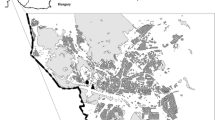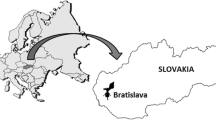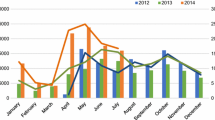Abstract
The aim of the study was to determine seasonal variation in concentrations of selected fungal spore types due to meteorological parameters. The presence of spores of thirteen taxa: Cladosporium, Torula, Alternaria, Botrytis, Epicoccum, Stemphylium, Ganoderma, Erysiphales, Entomophthora, Drechslera type, Didymella, Polythrincium and Pithomyces was recorded in Cracow using a Burkard trap. The majority of selected taxa belong to the anamorphic fungi group, the others to Ascomycetes, Basidiomycetes and Zygomycetes. Fungal spores were present in the air in large numbers throughout the summer with the highest levels being reached in June, July and August although their highest concentrations differed with time. For most of the studied spore types: Botrytis, Ganoderma, Alternaria, Epicoccum, Torula, Drechslera type, Polythrincium, Stemphylium and Pithomyces the peak period was recorded in August. Didymella and Entomophthora spores reached their highest concentrations in July while concentrations of Erysiphales and Cladosporium spores were highest in June. Multiple regression analysis was performed for two seasonal periods: pre-peak and post-peak. In the pre-peak period concentrations of 10 spore types: Cladosporium, Botrytis, Epicoccum, Stemphylium, Drechslera type, Pithomyces, Didymella, Erysiphales, Ganoderma and Entomophthora were strongest influenced by minimum temperature while Alternaria, Polythrincium and Torula by maximum temperature (significance level of α=0.05). During the post-peak period the most important factor affecting variation in concentrations of Botrytis, Polythrincium, Didymella, Erysiphales, Ganoderma and Entomophthora spores was the minimum temperature. For Alternaria, Cladosporium, Epicoccum and Torula the maximum temperature appeared to be the most influential, whereas for Drechslera type, Stemphylium and Pithomyces it was sunshine. All correlations between spore concentration, minimum and maximum temperature and sunshine were significant (significance level of α=0.05), and positive although the percentage of explained variation (R2) was low.
Similar content being viewed by others
References
K.F. Adams (1964) ArticleTitleYear to year variation in the fungus spore content of the atmosphere Acta Allergol XIX 11–50
Barnett H.L (1960) Illustrated Genera of Imperfect Fungi 2nd Edition Burges Publishing CO Minneapolis
J.M. Corden W.M. Millington (1994) ArticleTitleDidymella ascospores in Derby Grana 33 104–107
J.M. Corden W.M. Millington (2001) ArticleTitleThe long-term trends and seasonal variation of the aeroallergen Alternaria in Derby, UK Aerobiologia 17 127–136 Occurrence Handle10.1023/A:1010876917512
S. Cosentino P.L. Pisano M.F. Fadda F. Palmas (1990) ArticleTitlePollen and mould allergy: aerobiological survey in the atmosphere of Cagliari, Italy (1986-1988) Ann. Allergy 65 393–399 Occurrence Handle2244711
R.L. Craig E. Levetin (2000) ArticleTitleMulti-year study of Ganoderma aerobiology Aerobiologia 16 75–81 Occurrence Handle10.1023/A:1007682600175
G. D’Amato F.Th.M. Spieksma (1995) ArticleTitleAerobiologic and clinical aspects of mould allergy in Europe Allergy 50 870–877 Occurrence Handle8748718
M.R. Diaz I. Iglesias M.V. Jato (1997) ArticleTitleAirborne concentrations of Botrytis, Uncinula and Plasmopara spores in a vineyard in Leiro-Ourense (N.W Spain). Aerobiologia 13 31–35
D. Fernandez R.M. Valencia T. Molnar A. Vega E. Sagúes (1998) ArticleTitleDaily and seasonal variations of Alternaria and Cladosporium airborne spores in León (North–West, Spain) Aerobiologia 14 215–220
Grant Smith E (1990) Sampling and Identifying Allergenic Pollens and Molds. An Illustrated Identification Manual for Air Samplers. Blewstone Press San Antonio Texas
S.M. Hasnain (1993) ArticleTitleInfluence of meteorogical factors on the air spora Grana 32 184–188
B. Herrero M.A. Fombella-Blanco D. Fernández-González R.M. Valencia-Barrera (1996) ArticleTitleAerobiological study of fungal spores from Palencia (Spain) Aerobiologia 12 27–35
M. Hjelmroos (1993) ArticleTitleRelationship between airborne fungal spore presence and weather variables Grana 32 40–47
F. Infante E. Dominguez (1988) ArticleTitleAnnual variation of Cladosporium spores in home habitats in Cordoba, Spain Ann. Allergy 60 256–261 Occurrence Handle3348502
T. Kurkela (1997) ArticleTitleThe number of Cladosporium conidia in the air in different weather conditions Grana 36 54–61
L.S. Larsen (1981) ArticleTitleA 3-year-survey of microfungi in the air of Copenhagen 1977–1979 Allergy 36 15–22 Occurrence Handle7224107
D.-W. Li B. Kendrick (1994) ArticleTitleFunctional relationships between airborne fungal spores and enviromental factors in Kitchener-Waterloo, Ontario, as detected by Canonical correspondence analysis Grana 33 166–176
T. Mitakakis E.K. Ong A. Stevens D. Guest R.B. Knox (1997) ArticleTitleIncidence of Cladosporium, Alternaria and total fungal spores in the atmosphere of Melbourne (Australia) over 3 years Aerobiologia 13 83–90
L. Munk (1981) ArticleTitleDispersal of Erysiphe graminis conidia from winter barley Grana 20 215–217
A.H. Nikkels P. Terstegge F.Th.M. Spieksma (1996) ArticleTitleTen types of microscopically identifiable airborne fungal spores at Leiden, The Netherlands Aerobiologia 12 107–112
D. Southworth (1974) ArticleTitleIntroduction to the biology of airborne fungal spores Ann. Allergy 32 1–22
D. Stępalska K. Harmata I. Kasprzyk D. Myszkowska A. Stach (1999) ArticleTitleOccurrence of airborne Cladosporium and Alternaria spores in Southern and Central Poland in 1995–1996 Aerobiologia 15 39–47
F.J. Toro M. Recio M. Mar Trigo Particledel B. Cabezudo (1998) ArticleTitlePredictive models in aerobiology: data transformation Aerobiologia 14 179–184
Author information
Authors and Affiliations
Corresponding author
Rights and permissions
About this article
Cite this article
Stępalska, D., Wołek, J. Variation in fungal spore concentrations of selected taxa associated. Aerobiologia 21, 43–52 (2005). https://doi.org/10.1007/s10453-004-5877-2
Received:
Accepted:
Issue Date:
DOI: https://doi.org/10.1007/s10453-004-5877-2




